Welcome aboard! Skopik signs on as JLab's new Deputy Associate Director of Physics
Excellence among Lab staff: Isgur, Sinclair & Injector Group earn high praise from SURA
In their own words: Grad students share their perspective
Rutledge strives to discover answers through experimentation
- W-2 forms to be mailed no later than Jan. 31
- Blood Drive
- NASA scientist discusses Mars at February lecture
- Oooops, headline correction
DMV-On-Wheels provides quick, convenient service
Welcome aboard!
Skopik signs on as JLab's new Deputy Associate Director of Physics
by James Schultz
Dennis Skopik feels as if he's been in every church basement in the Canadian province of Saskatchewan.
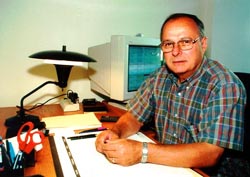 For the past four years, the former director of the Saskatchewan Accelerator Laboratory (SAL) at the University of Saskatchewan in Saskatoon spent the bulk of his time drumming up grass-roots support, raising money and meeting with federal and provincial bureaucrats and politicians. His mission: to obtain support for the Canadian Light Source, or CLS, the largest scientific project to be funded in Canada.
For the past four years, the former director of the Saskatchewan Accelerator Laboratory (SAL) at the University of Saskatchewan in Saskatoon spent the bulk of his time drumming up grass-roots support, raising money and meeting with federal and provincial bureaucrats and politicians. His mission: to obtain support for the Canadian Light Source, or CLS, the largest scientific project to be funded in Canada.
But that work is over. Jefferson Laboratory's new deputy associate director of physics says he is ready to shift his focus to the Physics Division and help Larry Cardman, associate director for physics. Skopik's new responsibilities include oversight of the Lab¹s environmental, health and safety programs, supervision of user interactions and regular contact with the Program Advisory Committee.
He will also be working closely with other Lab managers on the planned CEBAF upgrade to 12 billion electron volts (GeV) and on efforts to reduce to three years the current five-year backlog of approved experiments. "I wasn't brought in to fix anything," Skopik says. "I think this lab is extremely well run. People by and large are satisfied with how things are done and the track record is excellent. I don¹t see any major problems. My job is to ease the burden of work on Larry and to contribute to the Lab's long term planning."
Although Skopik became an official Lab staff member on July 1, he commuted regularly to Canada to wrap up CLS-related administrative matters until October. Skopik's office still bears the marks of a move in progress: unpacked boxes sit neatly in front of his desk and his office has the sparse look of the as-yet unsettled. He is, Skopik ruefully admits, "just trying to catch up."
SAL's program was a user-based physics program similar to Jefferson Lab's, albeit at a much lower energy of 300 million electron volts, or MeV. Skopik oversaw a staff of 55. But its focus on basic nuclear physics < now changing to applied research as the CLS comes online by 2003 < brought Skopik into regular contact with peers around the world, including JLab researchers.
Skopik says that it was fortunate that the JLab opportunity presented itself at roughly the same time the Canadian government decided to redirect SAL's mission away from basic to applied physics. "It was a logical time to change jobs," he says. "My first love is nuclear physics. This opportunity came along and it was a natural thing to do. In some sense, it's like coming home."
Skopik, a cooking enthusiast who is fond of French and Italian cuisine, isn't sure he'll have much time in the next few months to prepare from-scratch gourmet meals. He will make time for one thing: enjoyment of the Newport News weather. After having spent 30 years braving frigid Canadian winters, Skopik is looking forward to the Peninsula's relatively tropical climate.
"I tell people there are 40 reasons my wife and I are here, and they all have units of minus Fahrenheit degrees behind them," he quips. "It was pretty cold in Saskatoon."
Excellence Among Lab Staff
Isgur, Sinclair, Injector Group Earn High Praise from SURA
The Southeastern Universities Research Association and Jefferson Lab took the opportunity to recognize excellence among Lab staff during a special celebration in mid-December.
Nathan Isgur, chief scientist, and Charles Sinclair and the Injector Group he heads, were recognized for their dedication, leadership and the many contributions they¹ve made to the Lab and the nuclear physics community.
Lab Director Hermann Grunder kicked off the event by welcoming the many distinguished guests and expressing his delight at having the opportunity to recognize outstanding contributions made by Lab staff.
The first round of praise came from Donald Geesaman, Argonne National Lab and past chair of the Lab's Users Group Board of Directors, who spoke on behalf of the Lab¹s user community. He set the tone for the other speakers when he expressed the user community¹s delight with the quality of physics research made possible by the Continuous Electron Beam Accelerator Facility. He commended Isgur and Sinclair and the Injector Group for "opening new vistas of research at Jefferson Lab."
 Sinclair and the Injector Group were congratulated for developing a polarized electron source that has set new benchmarks in the experimental community. When originally planned and built, CEBAF did not include polarized beams. "Developing and bringing it on line took genius and hard work," Geesaman noted. The high levels of polarized beam and the beam¹s quality have already made it the tool of choice for today and into the next century among the Lab's users.
Sinclair and the Injector Group were congratulated for developing a polarized electron source that has set new benchmarks in the experimental community. When originally planned and built, CEBAF did not include polarized beams. "Developing and bringing it on line took genius and hard work," Geesaman noted. The high levels of polarized beam and the beam¹s quality have already made it the tool of choice for today and into the next century among the Lab's users.
When noting the contributions Isgur has made to nuclear physics, Geesaman said, "I'm a good enough scientist to marvel at what Nathan does, but I can only dream of approaching his level. The science at the Lab depends upon Nathan and his work on the construction of the quark." Geesaman applauded Isgur for the intellect, passion and direction JLab's chief scientist has brought to the nuclear physics community and the Lab. "This is the Lab that will solve the nuclear physics problems of the world," Geesaman proclaimed.
Bernard Frois, Saclay, France, followed Geesaman with additional comments and compliments from the user community. He spoke with a deep sense of pride in the accomplishments of Isgur and Sinclair. "These are wonderful people and we are where we are today [in nuclear physics] because of them. This Lab has no competitionS It achieves what is promised and is producing the finest data we ever thought possible. Today, Jefferson Lab is the center of the world for nuclear physics with electrons and photons, and for that we have these people to thank.
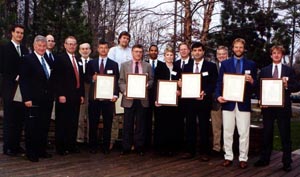 Personally recognizing Isgur was his colleague, Gabriel Karl from the University of Guelph, Toronto, Canada. He shared his recollections of a brilliant, hard working young physicist starting his first assistant professorship at the University of Toronto after completing his doctoral work. "As Nathan¹s first collaborator, my main achievement was letting him work as hard as he wanted," Karl quipped. "That collaborative work, where Nathan was left with the details," includes research papers that have received many hundreds of citations. This seminal research is the basis of large parts of the JLab physics program.
Personally recognizing Isgur was his colleague, Gabriel Karl from the University of Guelph, Toronto, Canada. He shared his recollections of a brilliant, hard working young physicist starting his first assistant professorship at the University of Toronto after completing his doctoral work. "As Nathan¹s first collaborator, my main achievement was letting him work as hard as he wanted," Karl quipped. "That collaborative work, where Nathan was left with the details," includes research papers that have received many hundreds of citations. This seminal research is the basis of large parts of the JLab physics program.
Christoph Leemann, the Laboratory's associate director for Accelerator, took the podium to recognize Sinclair and the Injector Group. He credited Sinclair and his team for perfecting the technology needed for high quality polarized beam. "They achieved fantastic results under very difficult circumstances," he said. "Polarized electron beam is an induced state of matter, with everything working against youS It took a strong multi-disciplinary team to bring us from behind < to the front." Leemann pointed to Sinclair's uncompromising standards, excellent teaching abilities and frugal budget management in making the Lab¹s polarized beam a success.
After the many accolades, SURA President Jerry Draayer presented Isgur, Sinclair and each member of the Injector Group with framed certificates of a SURA Board of Trustees resolution passed in their honor. Isgur's certificate cited his impact on "... our understanding of how nuclear physics is built from the fundamental quarks and gluons of Quantum Chromodynamics, his role in shaping the Laboratory's experimental program into a well-focused effort at the cutting edge of nuclear and particle physics research, and his key role in developing strong relationships between the Lab and universities throughout the Southeast and nurturing future physics research through numerous professorships."
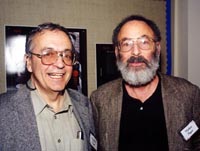 Isgur is especially proud of the dozens of professorships he has helped Jefferson Lab create. "The best thing a person can do is be a mentor," he said. "The success of Jefferson Lab depends upon university experimental and theoretical physicists. University professorships were shrinking. I'm proud of the role I played in promoting the brain power that will see us through the next several decades."
Isgur is especially proud of the dozens of professorships he has helped Jefferson Lab create. "The best thing a person can do is be a mentor," he said. "The success of Jefferson Lab depends upon university experimental and theoretical physicists. University professorships were shrinking. I'm proud of the role I played in promoting the brain power that will see us through the next several decades."
He humbly described his contributions to QCD, as "anticipating the direction nuclear physics was going and making others aware. It was daring [Quantum Chromodynamics], a new way to look at nuclear physics. I'm proud to be part of this community."
Sinclair described the praise as humbling and flattering but was quick to point out that these successes weren't due to the "efforts of an individual or even a group, but were the results of all of us." He expressed his gratitude for the opportunities he's had at Jefferson Lab and he thanked the Department of Energy and the taxpayer for building the lab.
In Their Own Words: Grad Students Share Their Perspective
Marcucci Enjoys Challenge of Theoretical Physics
Interviews by James Schultz
Laura Marcucci grew up in the small Italian town of Lucca, roughly 12 miles north of Pisa. She expects to graduate from Old Dominion University this coming summer with a Ph.D. in theoretical nuclear physics.
I'm not really sure why I became interested in physics. It just somehow happened. I do remember that when I was helping around the house helping my mother carry groceries, for example I'd be calculating forces, energy, that kind of thing. Stupid things, really, but I thought about them.
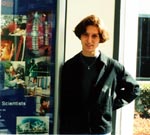 I started to play the piano when I was 12. By the time I was 16 or 17 the piano and physics were both very important. I chose physics, but I didn't give up the piano. I just decided to be a physicist who liked music rather than a musician who liked physics. I still play, even concerts sometimes, but it's getting harder to find the time to practice...
I started to play the piano when I was 12. By the time I was 16 or 17 the piano and physics were both very important. I chose physics, but I didn't give up the piano. I just decided to be a physicist who liked music rather than a musician who liked physics. I still play, even concerts sometimes, but it's getting harder to find the time to practice...
After I finished my undergraduate studies in Italy, I wanted to leave the small world where I grew up, to see different places. The United States was definitely the best place for graduate studies in theoretical nuclear physics. And in this country, Jefferson Lab is the place to be. Here they organize workshops and have speakers and you get to meet many people. Instead of your having to go elsewhere, people come here. You get to know them, they get to know you, and you can broaden your interests and be exposed to physics research different from your own. It helps.
I study the lightest nuclei, in particular helium3, helium4 and hydrogen3 (tritium). The approach I use views them as composed of three or four interacting neutrons and protons (nucleons). This approach, which basically ignores the presence of three quarks within each nucleon, is very simple and also very old. But theoretical models that describe the interactions among nucleons are now very accurate in predicting the experimental data. With this approach, I have studied electron scattering on nuclei of helium3 and hydrogen3. I've calculated the elastic form factors for a wide range of momentum transferred from the electron to the nucleus. I've also studied the reactions p+d-->helium3+photon and p+helium3-->helium4+positron+neutrino. This last process, in particular, takes place in the interior of the sun and plays a prominent role in our understanding of the very recent measurements of solar neutrinos by the immense underground liquid water detector in Japan called SuperKamiokande. Our goal in each of these calculations is to develop a theoretical framework which can both explain the existing data and predict results for experiments yet to be carried out.
The very refined models on which our approach is based are continuously tested and improved by calculating nuclear properties that can be or have been measured in research facilities like Jefferson Lab.
I've really found a lot of help in the Theory Group. You just knock at a door and someone is there to help you. It's great to have a problem and someone to help you figure it out. There's also a continuous exchange of ideas with other graduate students and post docs. And I really like having physics experiments going on close by. I'm calculating; they're measuring. Otherwise, it would be like living in an ivory tower.
It has struck me how few female physicists there are in the United States. At the graduate-student level, in Italy, it is about 20 percent female. Here it¹s probably 10 percent. I don't mind; it's OK. For me, gender is not an issue.
When I arrived, there was no graduate student association. There should be something here to help newly arrived foreign students with things like finding an apartment, establishing a credit history and so on. The biggest help I got was from my faculty advisor and his wife. They were great. But I think people are working on it, so maybe it will be better in the future.
Physics is not a nine-to-five job. You can't just stop thinking at a certain hour. Often, when everybody goes home, I¹m still here working. It¹s because theoretical nuclear physics is a lot of fun. I really like the calculations I¹m doing.
If I had to do it all over again, I¹d do it without thinking twice. Immediately. I admit I do miss Italy a little bit < the warmth and the friendships. But I¹ve made some good friends here, too.
My plan is simple: Keep going and find somebody to hire me. Right now I¹m applying for post docs [postdoctoral positions] back in Europe.
My job is the best hobby I could imagine.
Rutledge Strives to Discover Answers Through Experimentation
Gary Rutledge grew up outside Seattle, Washington. He expects to graduate from William & Mary this coming spring with a Ph.D. in experimental particle physics.
My father was a pilot in the Air Force. He retired and then spent most of his time buying and repairing old airplanes. He put them back together and I helped him. I learned how to machine aircraft parts to specific tolerances. We were picky because we had to be.
By my late teens I had decided to go beyond engineering. You could build new and different things but discovery was limited. I kept wanting to know why things worked the way they did. Asking those questions eventually gets you down to the atomic levels. Physics just had the answers. Physics courses were the ones that gave me the biggest challenge.
My father passed away while I was still an undergraduate. Due to financial concerns and some unfinished family business I left school and took a series of local jobs. I returned to school, four years later when I was 26. While I was finishing my electrical engineering degree I was hired by Boeing in Everett, Washington. I worked for them and went to school as well.
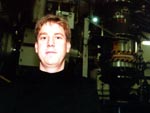 Going back to school was the best thing I could have ever done. I lost nothing because of the experience I brought with me. In the real world, I found that many people lacked discipline. I was really shocked to learn that I could jump in and get things done while others were still complaining they had something to do in the first place... I have a need for hands-on. I want to do things and see more connections to the real world.
Going back to school was the best thing I could have ever done. I lost nothing because of the experience I brought with me. In the real world, I found that many people lacked discipline. I was really shocked to learn that I could jump in and get things done while others were still complaining they had something to do in the first place... I have a need for hands-on. I want to do things and see more connections to the real world.
I came to Williamsburg in 1994. William and Mary had this bright, shiny new toy called CEBAF in their backyard. People were building a new thing. Ideas are being developed as we speak. To be part of this from the ground up is great.
That's why I love physics. It's working with new ideas, figuring out things to do with those ideas. When you come right down to it, it's play.
I arrived in Williamsburg with a set of precision machinist tools designed for the aircraft industry and experience in using them. I had my electronics background and, by then, a degree in physics. All together it was a perfect match for a Hall B project that was just starting. It was mechanically complex and had many physical qualities that needed to be understood. I also worked on developing the Hall A cryotarget. I oversaw the construction of HAPPEX detectors from start to finish, from design to installation. I gained invaluable experience working on the ground level with these projects and several others.
Being a graduate student at JLab is fantastic. The working conditions here are quite good. When you need parts you have them. There's nothing to stop you from creating. The attitudes of the people here are excellent. There¹s no hesitancy in working together.
The technicians make an incredible difference. They're easy to work with. When you call at four in the morning, they take your calls, answer your questions and fix your problems. If they don't know the answer to something, they¹ll tell you.
I've been in industry, so I've learned to work more efficiently with less upset. Assertiveness pays off. You can be assertive here without earning any black marks. This same attitude of getting things done doesn't always work elsewhere. The only thing I worry about is the possibility that some students could come in here and be lost in the hubbub. But the JLab student association should help.
I'd like to stay here at the Lab and take a post doc, directly from the Lab or a member institution. There will be openings that will present themselves. It might be Jefferson Lab. It might be Fermilab. It might be CERN. I'll go wherever a good job calls.
Editor's note: For more information about the Graduate Student Association go to JLab¹s main web page and click on "student/teachers" and follow the links.
Children's Holiday Party
The Children's Holiday party once again delighted staff and children alike. Santa visited, Toys for Tots donations were numerous and the outside trampoline dragon was a hit!
Don't toss 'em
Donate used greeting cards to St. Jude's Ranch
Jefferson Lab is still collecting holiday and greeting cards for use by the youth at St. Jude¹s Ranch for Children, according to Betty Beeler, Environmental, Health & Safety Reporting Office.
St. Jude's Ranch for Children is a nationally recognized nonprofit organization that focuses on the needs of abused, abandoned and neglected youth of all faiths and races.
Thirty years ago, founder Father Ward started recycling holiday and greeting cards as a fund-raising program. The children trim the cards and glue them onto pre-printed card backs, which are then sold to the public. Each child is paid 15 cents for each card he or she makes. The money the children earn is divided among savings, spending money and group outings.
To purchase Born Again Cards send $6.50 per package of 10 (along with the type of cards you wish to buy: Christmas, Hanukkah, New Year¹s, birthday, Mother's Day, Thanksgiving, etc.) to St. Jude's Ranch for Children, P.O. Box 60100, Boulder City, NV 89006-0100. Call 1-800-492-3562 for credit card orders. The St. Jude's Ranch Web site is at www.stjudesranch.org.
Beeler encourages everyone from the Jefferson Lab community to participate by bringing in their used greeting cards. "The ranch only uses the fronts of the cards," she points out. "The backs will be removed. Also, make sure personal letters and photos are removed from the cards."
The Lab started collecting cards last holiday season as part of the Department of Energy's greeting card recycling program to benefit St. Jude's Ranch for Children.
Collection boxes are located in the CEBAF Center reception area, VARC reception area, Machine Control Center, Applied Research Center and Trailer City.
This program is a delightful approach to reducing landfill waste while contributing to the needs of a very special charity, Beeler says. Call Yvonne Casalino, ext. 7844, or Beeler at ext. 7491 for more information.
The Lab sent 4400 cards to benefit St. Jude's Ranch youth early this year and has another 4000 ready to mail early in 2000.
Briefs
W-2 forms to be mailed no later than Jan. 31
The Finance section reminds all Lab staff that W-2 tax forms will be sent out no later than Monday, January 31. To ensure you receive your W-2, Maureen Davis, Pay and Travel Section, encourages anyone who has had a change of address during 1999 to check their address in the CEBAF Information System (CIS) and make sure it is correct.
Anyone needing to update their mailing address should see Kisha Owens, Human Resources, room 40-A in the VARC to fill out a change-of-address form. She also has federal and state W-4 exemption forms for anyone needing to change their federal or state withholding rate.
The Lab is hosting its semi-annual Red Cross blood drive on Thursday, January 27 in the VARC.
"We had a fantastic turnout for the last blood drive and we hope to have a large turnout for this one, too," says Cheryl Batten, Medical Services coordinator. The July 1999 blood drive netted 81 units < nine from first-time donors < both new records for the Lab.
"Our donor goal this time is 100," Batten adds. "And to kick off the first blood drive of the new year, we're giving away T-shirts to the first 100 donors." The shirt features a specially designed JLab blood drive logo by Katie Hickson, 12-year-old daughter of Steve Hickson, physics.
Batten encourages everyone interested in participating to sign up by calling her at ext. 6269, or e-mail batten@jlab.org by January 24 so adequate Red Cross staff and volunteers can be scheduled for the day. She urges all participants to make an appointment as it helps to keep the blood drive running smoothly. "If you want to participate but can¹t schedule an appointment, call and register as a ?walk-in or maybe¹ so the Red Cross sends enough workers to manage our crowd," Batten asks.
The blood drive will run from 10 a.m. 4 p.m. in rooms 53/55 in the VARC. The JLab van will be available to shuttle donors between work and the VARC. Watch for more information. This blood drive is taking place in the VARC.
 NASA scientist discusses Mars at February lecture
NASA scientist discusses Mars at February lecture
Jefferson Lab's Spring Science Series will kick off on Tuesday, February 15 at 7 p.m. in the CEBAF Center auditorium.
The event will feature a local NASA scientist discussing Earth¹s elusive neighbor: the planet Mars.
Oooops, headline should¹ve read "communication"
The On Target staff apologizes for the headline error on page 1 of the November newsletter.
We didn't notice the missing "m" in "communication" before the newsletter went to print. We apologize for the error and thank a reader for pointing out the mistake.
DMV-On-Wheels provides quick, convenient service
The Department of Motor Vehicles mobile customer service center will make monthly visits to Jefferson Lab throughout 2000.
Take advantage of this convenient opportunity to take care of a number of your driving and vehicle needs, urges Cela Callaghan, Accelerator Division. "Taking advantage of this service allows you to save your vacation time and Saturday mornings for other activities," she points out.
People may visit the mobile unit to:
- Take driver¹s license written tests
- Obtain an original driver¹s license
- Get a duplicate driver¹s license
- Renew their driver¹s license
- Take the Commercial Driver¹s License written test
- Get a copy of their driving record report
- Update driver information (address, name changes, etc.)
- Obtain photo identification cards
- Register, renew and title vehicles
- Turn in license plates and vehicle registrations
- Obtain vehicle decals
Anyone with DMV-related questions is also welcome to stop by the mobile customer service center.
The scheduled Lab visits for 2000 are January 24, February 28, March 27, April 24, May 22, June 26, July 24, August 28, September 25, October 23 and November 27. The visits are set for the fourth Monday of each month. On the days the mobile unit visits, it will be in the parking lot behind the Forestry Building (building 19). Hours of operations are 9 a.m. 4 p.m.
Bright Spot on the Web
Editor¹s note: If you have or know of a website that could be informative or useful to Jefferson Lab staff, call the public affairs office at ext. 7689 or e-mail Linda Ware (ware@jlab.org).
Find out about the Jefferson Lab Activities Group (JAG) and the activities and events it supports by visiting the JAG Web site at http://www.jlab.org/intralab/committees/jag/. The Web site has pages on Lab team sports, clubs and upcoming events. It includes the JAG charter, mission and committee members, and even features a page highlighting JAG T-shirts, hats and other memorabilia that are for sale.

